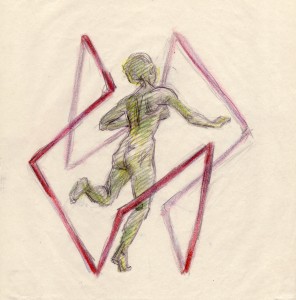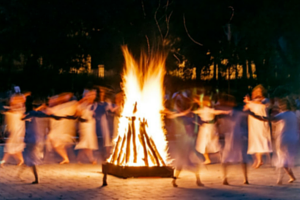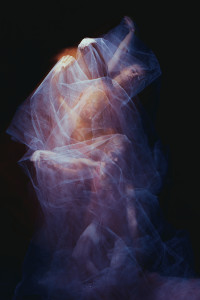 As any performer who has ever worked with technology knows, interfacing human and machine elements is a time-consuming process. Our experiment with motion capture was no exception.
As any performer who has ever worked with technology knows, interfacing human and machine elements is a time-consuming process. Our experiment with motion capture was no exception.
Fortunately, we had wonderful people to work with – our dancers, Professor Roger Good and his students and staff from the OU School of Digital Media Arts, and Nathan Berger and Rakesh Kashyap from the OU Aesthetic Technology Lab. The latter two were responsible for the motion capture recording, using a portable MOCAP suit. This had to be fitted and calibrated on each dancer in order to produce a clean recording. And this often involved painstaking recalibrations between performances.
It was a very long day, but we managed to record the scales we wanted to capture, along with a dance class exercise, an improvisation, and a section of one of Jean Erdman’s choreographies. Now even harder work followed, for Madeleine and I had to learn to read the MOCAP recordings.
While we had certainly captured the trace-forms, they were merely white lines against a black background. The recording had no visual depth; that is, we could not easily discern which lines represented motion in the front part of kinesphere and which lines represented movements in the dancer’s back space.
Berger and Kashyap came to our rescue here, by creating as skeletal icosahedron that could be superimposed to help us decode the MOCAP tracery. But this introduced other problems – should the icosahedron turn when the dancer turned, or remain stationary? Should it tilt if the dancer did, or not? MOCAP reintroduced issues around systems of reference that have been dealt with in Labanotation.
As with all pilot research projects, Madeleine and I discovered how much we still had to learn. Nevertheless, a few intriguing findings emerged. Learn more in the next blogs.

 Polar triangles, axis and girdle scales, primary scales, and the A and B scales – these were the Laban prototypes we wanted to study. Thus the research project began with a crash course in space harmony for three Ohio University dance faculty (Travis Gatling, Tresa Randall, and Marina Walchi).
Polar triangles, axis and girdle scales, primary scales, and the A and B scales – these were the Laban prototypes we wanted to study. Thus the research project began with a crash course in space harmony for three Ohio University dance faculty (Travis Gatling, Tresa Randall, and Marina Walchi). In 2008, Professor Madeleine Scott and I ran a
In 2008, Professor Madeleine Scott and I ran a 



 In the preface to Choreutics, Laban defines “choreography” as the “designing or writing of circles.” While we use the word today to designate composing dances, Laban was obviously familiar with the origins of the term, which come from two Greek words – khoros and graphein.
In the preface to Choreutics, Laban defines “choreography” as the “designing or writing of circles.” While we use the word today to designate composing dances, Laban was obviously familiar with the origins of the term, which come from two Greek words – khoros and graphein. Dance is often viewed as a form of self-expression. But everyone expresses themselves through their bodily movements. These quotidian expressions differ from dance in an important way however, for
Dance is often viewed as a form of self-expression. But everyone expresses themselves through their bodily movements. These quotidian expressions differ from dance in an important way however, for We have no sensory mechanism for perceiving time. And yet we are aware of time as a phenomenon closely related to movement. On some uncanny occasions, time appears to stand still. But mostly time seems to move like a dancer – sometimes quickly, sometimes slowly.
We have no sensory mechanism for perceiving time. And yet we are aware of time as a phenomenon closely related to movement. On some uncanny occasions, time appears to stand still. But mostly time seems to move like a dancer – sometimes quickly, sometimes slowly.